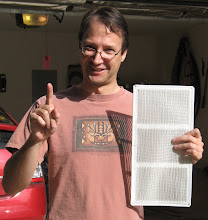
Having determined that I cannot afford to hire 20 or 30 people to spend most of their waking lives pedaling bikes to power my house (20 people for 12 hours at $8.00/hr = almost $2000 per day!!!) , I wondered if there might not be other, non-power-grid ways of getting my home powered. After all, Texas is blessed with pretty good sunshine; not as good as the desert Southwest of this country, but well above average. Perhaps I can power my home with solar panels, using some of that energy to my advantage, rather than just fighting it, to reduce its effect of heating my house up through the summer months.
I've got roughly 500 square feet of roof space that might be exposed to enough sunlight for panels to make sense. (This is my estimate; I'd have to get a real professional to look at it for a final number). According to a nice solar system calculator at findSolar, which takes into account the measured sunlight in my area, I might be able to just fit a system into my roof space.
So my electricity needs are solvable with solar, since I seem to have about the required roof space. (I realize that the sun doesn't shine at night; but my house is grid-tied, so I can pull from the grid at night or on cloudy days. I would effectively put energy back into the grid on sunny days where I didn't need all of it; the proposed system is sized to cover my needs as averaged throughout the year, so my net draw from the grid over a year would be 0.)
The solar calculator estimates that the system would cost me around $20,000 (including various rebates and credits). While that's a chunk of change, once I spend it, it covers my energy costs for quite some time. Compared to paying people $2000/day to pedal bikes, this justifies itself after just 10 days. And since panels last for decades (although some of the ancillary equipment won't), this is looking like not too bad a bargain.
So the solar option is clearly better than paying people to pedal. But a more subtle question then arises: is it better for me to spend money buying solar panels, or is it better for me to continue to reduce my energy usage with efficiency measures?
And so we start down the road that most people considering these sorts of things travel: how much do I spend up front vs. how much do I save over time? If I consider $20,000 an investment, what effective interest rate does it pay me? In fact, to know this, I need to know what is the future cost of the electricity it is offsetting, which is, of course, a guess. Like any investment, this "calculation" involves guesswork about the future of the investment, the future of the market, etc.
Looking at what I spent on electricity in 2007, roughly $700.00, the panels might take $20,000 / $700 = about 28 years to pay off in electricity savings, at current electricity prices. That's a return of roughly 3.5%, which is far lower than my efficiency investments have returned. That rate of return for solar will go up as electricity prices go up; however, so will the rate of return on my efficiency investments. So at this point, it's still looking to me like efficiency is the way to go, until I've gotten to the point that the estimated rate of return on those drops to below 5%, or until solar panels undergo another dramatic price drop.



No comments:
Post a Comment